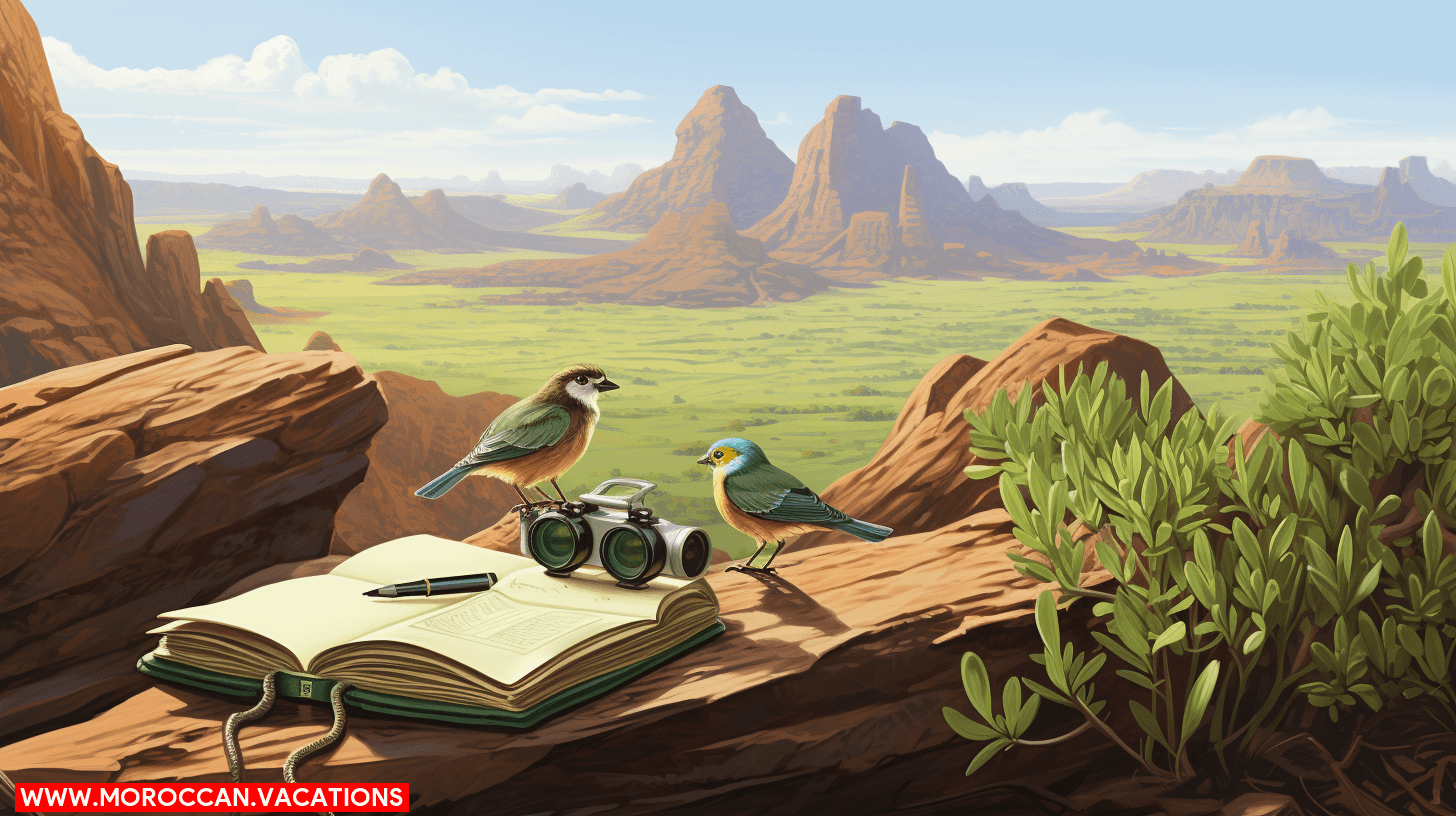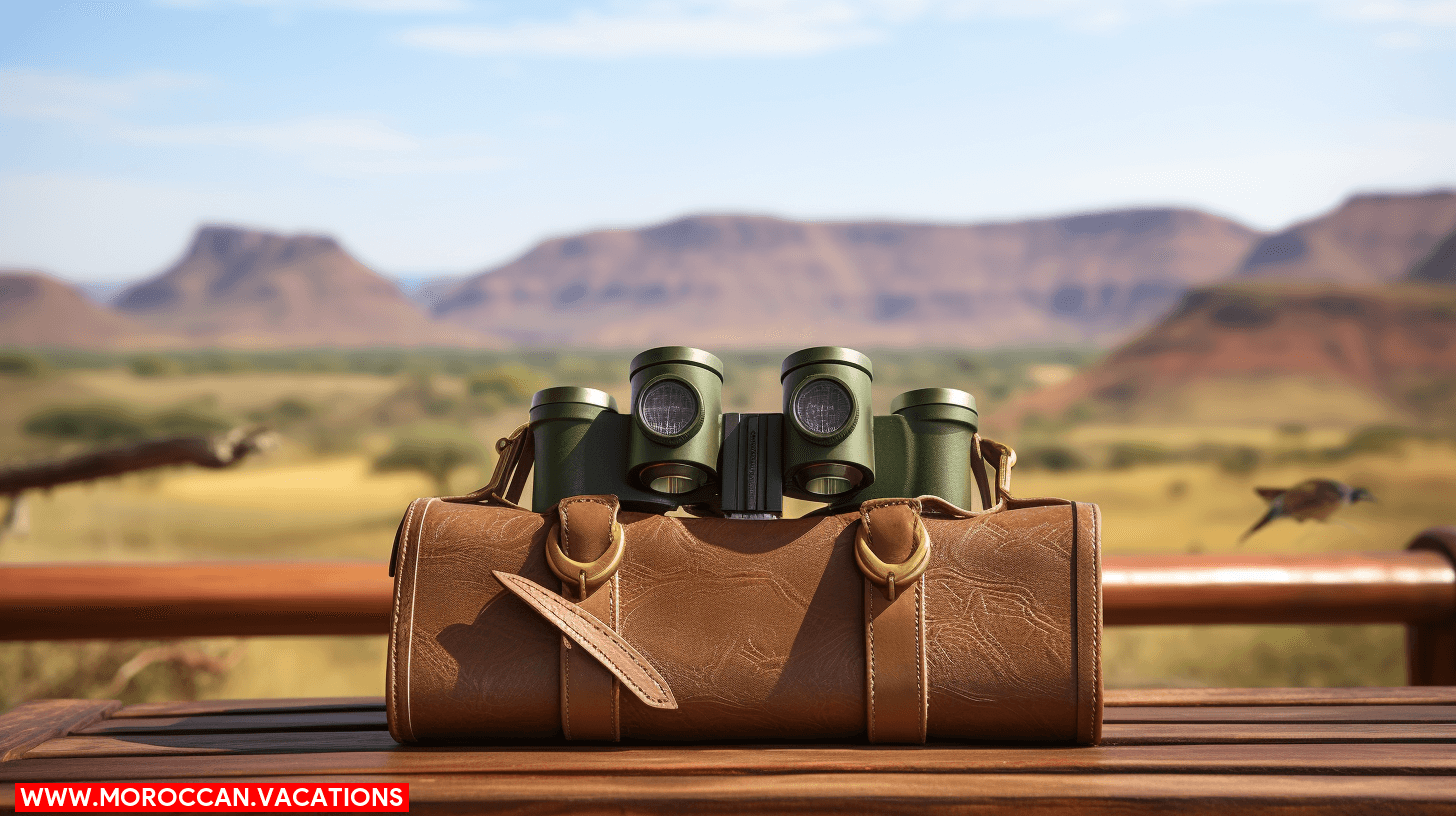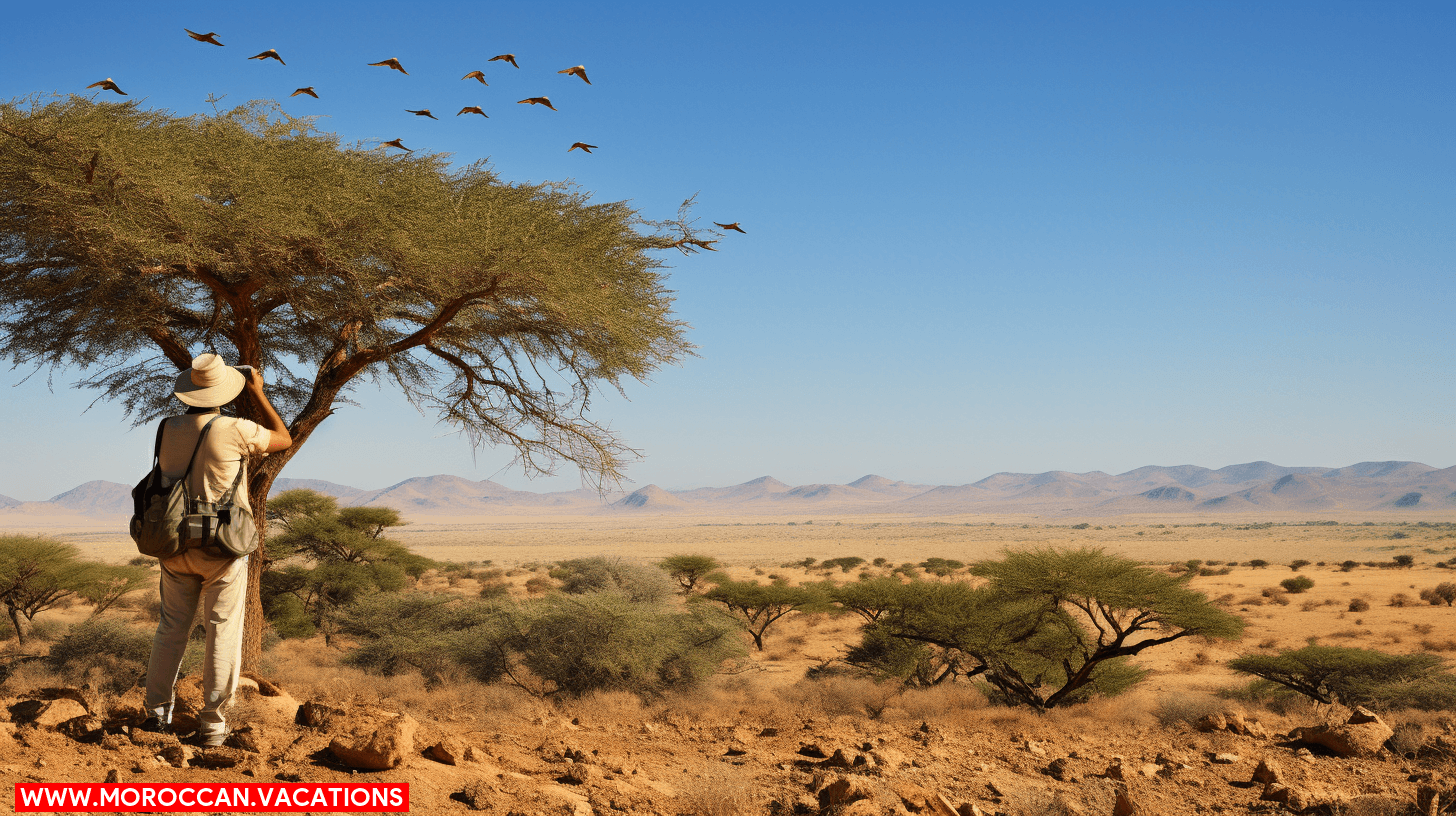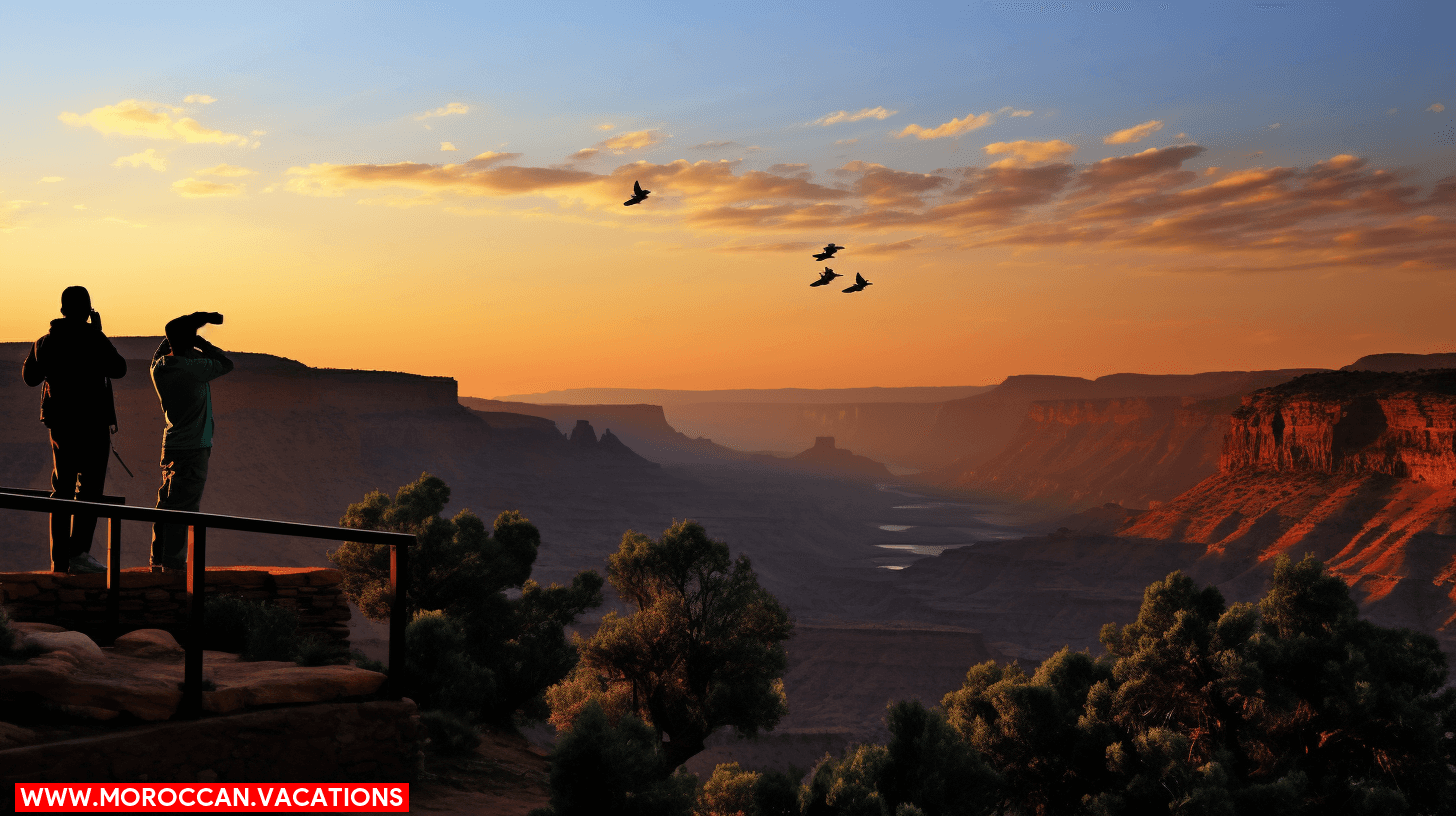The Purpose of Bird-Watching Tools


You’re in Dades Valley, bird-watching paradise, but can’t clearly see that vibrant bird on the distant tree. Frustrating, isn’t it? That’s where your binoculars become your best friend, bringing life’s little wonders closer. Welcome to ‘Binocular Bliss: Bird-Watching Essentials in Dades Valley’. We’ll guide you through picking the perfect binoculars and field guides to enhance your bird-watching journey. So, gear up, nature’s calling!
Understanding the purpose of bird-watching tools can significantly enhance your overall experience, providing you with the clarity you’ll need to identify different species confidently. As a birder in Dades Valley, your essentials should include binoculars, a field guide, a notebook, and a solid pair of walking shoes.
Binoculars are crucial birdwatching tools, bringing distant birds into sharp focus, enhancing colors, and revealing details that would be invisible to the naked eye. A decent pair will make all the difference in your enjoyment and success.
A field guide, meanwhile, is like a dictionary for birders. It’s your go-to for identifying and learning about the birds you spot. You’ll appreciate having this handy reference when you’re stumped by a tricky species.
Don’t dismiss the value of a simple notebook. It’s an essential accessory for birders, allowing you to record observations, make sketches, and track your sightings over time.
Lastly, comfortable walking shoes are paramount. Birding often involves a lot of walking in varied terrains. A good pair of shoes will leave you free to focus on the birds, not your aching feet.
Embrace these Dades Valley bird-watching essentials and you’ll be well on your way to a rewarding birding adventure.
Choosing the Right Binoculars


Choosing the right binoculars can make or break your bird-watching experience in Dades Valley. You’ll want to consider magnification, as it’s crucial for spotting those distant feathered friends. Factor in weight and comfort for extended use, and don’t forget about weather-resistant features to brave any weather conditions.
Binoculars Magnification Importance
You’ll need to pay careful attention to binocular magnification when selecting the perfect pair for bird-watching in Dades Valley. The right magnification is crucial for successful bird-watching outings. It determines how close you can bring the subject without physically moving closer. Usually, bird watchers prefer binoculars with 7x to 10x magnification. Any more can make the image unstable, while any less could leave you squinting.
Here’s a handy guide:
| Magnification | Best for |
|---|---|
| 7x | Wide field views |
| 8x | General bird-watching |
| 10x | Detailed observations |
Weight and Comfort
Once you’ve zeroed in on the right magnification, don’t overlook the weight and comfort of your binoculars. A pair too heavy can strain your neck and arms, robbing you of the freedom to explore Dades Valley’s avian delights with ease.
When choosing binoculars, consider:
- Weight: Opt for a lightweight model, especially for extended bird-watching sessions.
- Ergonomics: Your binoculars should feel comfortable in your hands. Test a few models before making a decision.
- Eye Relief: Look for binoculars with adjustable eyecups, great if you wear glasses.
- Neck Strap: A padded neck strap can distribute weight evenly, reducing strain.
Weather-Resistant Features
While you’re enjoying your bird-watching adventure in Dades Valley, it’s crucial that your binoculars can withstand the elements. Your gear should be as resilient as you are, ready to brave the unpredictable weather. Look for binoculars with weather-resistant features. These include waterproofing and fog proofing, both crucial in maintaining clear, unobstructed views.
Waterproof binoculars are sealed with O-rings to prevent moisture, dust, and debris from penetrating. This feature is a lifesaver during sudden rain showers. Fog proofing, on the other hand, is achieved by filling the binoculars with nitrogen or argon gas. This prevents internal fogging, ensuring you won’t miss out on any bird sightings due to condensation. Choose wisely, your adventure depends on it.
Mastery of Field Guides Usage


You’ve got your binoculars, now let’s master the field guides. Field guides are your roadmap to the bird-watching world, so understanding their icons is crucial for a successful outing. Picking the right guide and using it effectively can transform your bird-watching experience in Dades Valley as you learn to identify species with ease.
Understanding Field Guide Icons
In the realm of bird-watching, mastering the use of field guide icons isn’t just helpful, it’s essential. These icons provide crucial information about a bird’s size, habitat, and behavior. They can be your roadmap to identifying a species swiftly, even when it’s partially hidden or in flight.
You’ll often come across these icons:
- The silhouette icon, indicating a bird’s size and shape.
- The habitat icon, revealing where you’re likely to spot the bird.
- The behaviour icon, illustrating the bird’s typical actions or movements.
- The map icon, showing the bird’s distribution and migration patterns.
Understanding these symbols liberates you from confusion, allowing you to immerse fully in the bird-watching experience. Master these, and you’ll navigate the bird-watching realm with ease and confidence.
Choosing Right Field Guide
Choosing the right field guide requires a mastery of its usage, and it’s your key to unlocking a world of bird-watching wonders. It’s not just about picking any guide off the shelf; you have to know what you’re looking for. Consider your environment. If you’re exploring Dades Valley, choose a guide that specializes in its rich bird species. Look for detailed illustrations and accurate descriptions. Cross-check with online resources to ensure the guide’s credibility. It’s also essential to understand how the guide is organized. Is it by color, size, habitat, or behavior? Pick the one that suits your style of learning. Remember, the guide is your companion in this journey, choose wisely and enhance your bird-watching experience.
Effective Guide Usage Tips
While you’ve made the important step of selecting the right field guide, it’s equally critical to master its usage for an optimal bird-watching experience. Here are some tips to get the most out of your guide:
- Always carry it with you. You never know when you’ll spot a bird that you can’t identify.
- Take time to familiarize yourself with the layout of the guide. Knowing where to find information quickly will enhance your bird-watching experience.
- Use the index. It’s a fast way to locate specific birds in the guide.
- Practice at home. Try identifying birds in your backyard or local park using the guide.
Best Bird-Watching Locations in Dades Valley


Scouting out the best bird-watching locations in Dades Valley can significantly enhance your ornithological adventure. This lush valley, enclosed by the High Atlas and Anti-Atlas Mountains, offers a rich diversity of bird species to spot.
Start at the heart of the valley, where the Dades River flows. It’s a magnet for waterfowl and migratory birds. You’ll find herons, spoonbills, and perhaps even the elusive kingfisher. Don’t forget to explore the reed beds, they’re home to warblers and reed buntings.
Take a day trip to the higher altitudes, near M’goun Massif. The rugged terrain here is a haven for raptors, including golden eagles and peregrine falcons. If you’re lucky, you might spot the rare Bonelli’s eagle .
Stop by the almond and olive groves too, they’re not just picturesque, they teem with finches, sparrows, and various songbirds.
Proper Maintenance of Bird-Watching Equipment


So, how can you ensure your binoculars and other bird-watching equipment stay in top shape for these unforgettable experiences in Dades Valley? Proper maintenance is key, and it’s simpler than you might think.
First off, let’s consider the basic care steps:
- Clean your binoculars regularly, but gently. Use a soft cloth and specialized cleaning solutions to avoid scratching the lenses.
- Store your equipment in a cool, dry place. Humidity and high temperatures can damage the delicate optics.
- Keep your gear in protective cases when not in use. This prevents dust accumulation and accidental drops.
- Lastly, if your equipment needs repair, always use a professional service. It’s tempting to try and fix things yourself, but you might end up causing more harm.
Packing Essentials for Bird-Watching


When you’re gearing up for a bird-watching expedition in Dades Valley, it’s crucial that you pack the right essentials. Each item you bring should serve a purpose and enhance your experience, while not weighing you down.
The first and most important item is a pair of reliable binoculars. You’ll need them to spot birds from afar and observe their behaviors without disturbing them. Secondly, a field guide is indispensable. It’ll allow you to identify various species and learn about their habits.
Ensure you have a notepad and pen for documenting your sightings. It’s an enjoyable part of bird-watching, allowing you to keep track of your experiences. Lastly, pack a compact digital camera. It will let you capture stunning images of birds in their natural habitat.
Here’s a quick visual representation of the packing essentials:
| Essential Item | Purpose |
|---|---|
| Binoculars | Spot and observe birds from afar |
| Field Guide | Identify species and learn about their habits |
| Notepad and Pen | Document sightings |
| Digital Camera | Capture images |
Tips for Identifying Birds in Dades Valley


How can you accurately identify the various bird species you encounter in Dades Valley? The answer lies in a mixture of knowledge, observation, and a little bit of technology. Here, we offer some tips to help you distinguish between different species and really enhance your bird-watching experience.
- Look for distinguishing features: Pay attention to color patterns, size, and shape. A bird’s beak, tail, and wings can also provide clues about its identity.
- Listen to bird songs and calls: Many bird species have unique sounds. There are plenty of apps and guides that can help you identify birds by their calls.
- Observe behavior and habitat: Birds behave differently and prefer different environments. Noting where you see a bird and what it’s doing can provide valuable clues.
- Use a field guide or app: These tools can be invaluable for identifying birds, especially if you’re new to bird-watching.
Weather Considerations for Bird-Watching


As you plan your bird-watching trip to Dades Valley, it’s crucial to consider the weather’s impact on birds and how it may shape your experience. Don’t be deterred by a forecast of rain, as rainy days can offer unique bird-watching opportunities. Be aware too, of the seasonal bird patterns, as they can greatly influence which species you’ll encounter.
Weather’s Impact on Birds
Despite packing all your essential bird-watching tools, you’ll need to consider the weather’s impact on birds before venturing into Dades Valley. Weather conditions can significantly affect bird behaviors and migration patterns.
- Rain: Birds usually seek shelter during heavy rains, making them difficult to spot. A light drizzle, however, may result in increased feeding activity.
- Wind: Strong winds can disrupt flight paths. Conversely, calm days might encourage more birds to take flight.
- Temperature: Extreme temperatures can influence bird activity. Birds are more likely to be active during cooler parts of the day.
- Seasons: Different seasons attract different species. Migratory patterns mean certain birds only appear in specific seasons.
Understanding these elements helps ensure a fruitful bird-watching expedition, keeping you in harmony with nature’s rhythm.
Rainy Day Bird-Watching
When you’re planning a bird-watching trip on a rainy day in Dades Valley, it’s essential to understand how the weather can affect bird behaviors. Rain can make birds less active as they seek shelter, but it also drives worms and insects out, making it a feast for certain species. Spotting these feeding frenzies can be a real treat. To stay dry, invest in a quality raincoat and waterproof boots. Opt for binoculars with a high-quality lens coating to prevent fogging. Remember, patience is key. Birds may not appear immediately, but they’ll venture out once the rain lessens. Embrace the freedom of observing nature’s resilience and adaptability, turning an otherwise gloomy day into an opportunity for discovery.
Seasonal Bird Patterns
Just like your rainy day bird-watching adventures, understanding the seasonal bird patterns can significantly improve your overall experience in Dades Valley. Weather is a crucial influencer of bird behaviors. Each season brings a unique set of bird species and behaviors to observe.
- Spring: Birds return from their winter migration, providing a spectacle of colors and sounds. It’s breeding season, so you’ll see courtship displays.
- Summer: Many birds are nesting, and by late summer, fledglings learn to fly.
- Autumn: Birds prepare for migration. You’ll spot flocks gathering and feeding heavily.
- Winter: A quiet time, but you can watch hardy local species and winter visitors.
Documenting Your Bird-Watching Experience


You’ll find that documenting your bird-watching experience can greatly enhance your overall enjoyment and understanding of the diverse avian life in Dades Valley. It’s not just about identifying and observing birds; it’s also about recording your observations in a meaningful way. A well-kept bird-watching journal can serve as a personal catalog of your encounters with the fascinating avian species that call this valley home.
Start by noting the date, time, and location of each bird sighting. Describe the bird’s appearance – its size, color, markings, and behaviors. Capture your observations, thoughts, and questions. This detailed record will not only help you remember your encounters but also allow you to track patterns and changes over time.
A camera can also be an invaluable tool for documenting your bird-watching experience. A picture is worth a thousand words, after all. Photographs can provide visual evidence of rare sightings, and they can reveal details that you might have missed during your initial observation.
Building Community Through Bird-Watching


Bird-watching isn’t just your solo adventure; it’s also a great opportunity to build your community’s love for nature. When people gather to notice the world around them, they foster a shared connection that transcends their individual differences. You can be the catalyst for this community growth in Dades Valley.
Here’s how:
- Organize weekly bird-watching walks: This not only gives people a chance to learn from each other but also encourages regular interactions, fostering a sense of community.
- Start a local bird-watching club: This can serve as a platform where everyone can share their unique sightings and experiences.
- Arrange workshops and seminars: Invite experts to share their knowledge, enhancing the understanding and appreciation of birds in your community.
- Promote citizen science: Encourage members to document their sightings and contribute to national bird databases.


Samira Amrani
The passionate author behind Moroccan Vacations, sharing her expertise and love for Moroccan culture, cuisine, and travel experiences to inspire wanderlust in every reader.
Related Articles
Aromatic Gardens: Exploring Marrakesh's Fragrant Plants and Herbs
You step into a world of intoxicating scents, where every breath transports you to a realm of botanical bliss. Welcome to the aromatic gardens of Marrakesh, where nature's fragrant treasures await your exploration. From the...
The Healing Power of Nature: Therapeutic Gardens in Marrakesh
History of Therapeutic Gardens in Marrakesh Imagine stepping into a lush oasis, surrounded by vibrant colors and the soothing sounds of nature. In Marrakesh, therapeutic gardens offer a sanctuary for healing and rejuvenation. Discover the power of these enchanting...
Starry Nights: Star-Gazing in Dades Valley
Discovering Dades Valley's Night Sky Ever gazed up at the night sky and felt dwarfed by its vastness? Welcome to Dades Valley, your gateway to the cosmos. Here, you'll traverse the celestial realm, identifying constellations and spotting shooting stars. You're not...


